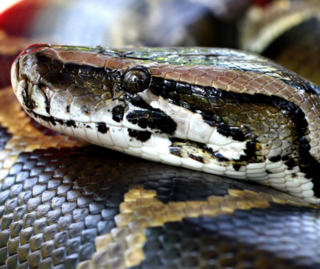I watched the little blonde-headed girl, who looked to weigh about 40 pounds, skipping down the nature trail in the Everglades National Park, and it crossed my mind that she would make a pretty good meal for a big snake...

I recently took to heart John Lennon's advice to "get back to where you once belonged." For me that's the beaches and swamps of south Florida were I was born and raised. In mid-December, my wife and I headed down I-75 for a couple of weeks of trash novels and beach time on Sanibel Island with a side trip to the Everglades. While Mary Jean was deep into the adventures of a Randy Wayne White novel about Doc Ford, Sanibel's fictional action hero, my recreational reading consisted of two hot-off-the-press contributions to our understanding of giant snakes that kill people.
Big Snakes and Small People = Trouble
My beach reading started with an article in the prestigious Proceedings of the National Academy of Science titled "Hunter-Gatherers and Other Primates as Prey, Predators, and Competitors of Snakes." It was written by Thomas Headland, a cultural anthropologist, and Harry Greene, an old grad school pal of mine who is now a professor at Cornell.
Back when I was a geeky teenage snake-collector, it was widely believed that even the largest of serpents did not prey on humans. Wrong. Headland lived for 24 years with the Agta Negritos, an isolated hunter-gatherer group on the Philippine island of Luzon. During this time, he interviewed 120 of the Agta about their encounters with the longest snakes on earth, reticulated pythons. These animals were common on Luzon, and they can grow to 20 or 30 feet long and weigh170 pounds. The average adult male Agta, in contrast, is less than five feet tall and weighs 100 pounds.

Big snakes and small people are a bad combination. According to Headland and Greene, between 1940 and 1973, six Agta were killed by pythons, and 26% of Agta men and 2% of the women had been attacked by them. In one case, a man was swallowed by a python and his body recovered by his son who killed the snake and found his father in the animal's stomach. In a particularly horrifying case, a python slithered into a hut and killed a four year-old child and her three year-old brother. The snake was in the process of swallowing one of the children when their father came home and killed the snake. Headland and Greene estimate that before they had machetes and guns, about 4% of Agta people died in an encounter with a python. That's roughly the same odds that an American has of succumbing to Alzheimer's disease.
Out of Asia...and into Florida
Being squeezed to death (technically, suffocated) by a reptile is high on my list of bad ways to go. I was still haunted by the Headland and Greene article the next day when, while browsing the shelves of the visitor center of the Ding Darling Wildlife Refuge, I came across a new book on the rapid invasion of Burmese pythons into south Florida. So rather than starting the Doc Ford novel Mary Jean had just finished, I spent the next two days laying on the beach reading Invasive Pythons in the United States: Ecology of an Introduced Predator by Michael Dorcas and John D. Wilson. Despite the title, it's a terrific piece of science writing. And it's scarier than a Doc Ford novel.
Here's the deal. Roughly 400,000 American households include a pet snake, and among the most popular of reptilian companions is the Burmese python. These animals are hardy, breed readily in captivity, and have sweet personalities. They can be beautiful. (Freud would have loved Brittany Spears' stage act which featured a bump and grind with a stunning seven foot albino Burmese.) These animals, however, can live for twenty five years and they never stop growing. Hence, the 18 inch baby that looked so cute in the pet shop will soon morph into an unmanageable 10 footer that wants a rabbit for lunch rather than a mouse. What do you do when your girlfriend says "Either the snake goes or I go?" You drive deep into the Everglades down Highway 41, wistfully say good bye to your pet, and watch it silently slip into Florida's river of grass.
Together with the occasional escaped pet, this scenario has played out enough times that giant constrictors have become, well.... a big problem. Stray Burmese pythons started showing up in the Everglades in the mid 1980s, and by the late 1990s they were breeding in the swamps. South Florida is perfect python habitat and their population has been growing at an exponential rate. Female pythons can lay 40 or more eggs at a time, and, remarkably, even females that cannot find a mate can reproduce through a form of virgin birth called facultative parthenogenesis. Every attempt to eliminate these animals -- trapping, hunting them down with dogs, and offering bounties for their corpses -- has failed. Today Burmese pythons are thriving throughout south Florida. While no one really knows how many there are, herpetologist Michael Dorcas puts their numbers in the hundreds of thousands.
The sudden appearance of an exotic top predator is bad news for man and beast (see here). Burmese pythons can eat nearly anything with fur or feathers. These include dozens of species of rare birds, the endangered Key Largo wood rat, full grown deer, and, possibly, the nearly extinct Florida panther. They even eat good sized alligators.
Are the pet dogs and cats of Floridians on the menu for our homegrown pythons? Absolutely. But what about children? Dorcas and Willson note that pythons have killed at least nine people in the United States since 1999. All of these cases, however, have involved pet snakes. Perhaps the most horrific incident occurred in 2009 when a two year old Florida toddler was killed in her bed by a 9 foot Burmese python who had escaped from its cage. (The girl's mother and her boyfriend were convicted of third-degree murder and sentenced to 12 years in prison.) While wild Burmese pythons have killed people in Asia, there is no case of a wild-born python killing a person in the United States...yet.
Coming to a Basement Near You?
It only took Burmese pythons a decade to invade most of south Florida. Should you be worried that one will eat your Basset hound or show up in your basement? It depends on where you live. In Asia, the range of the Burmese python extends surprisingly far north, well into the foothills of the Himalayas. Experts disagree on their potential range in the United States. The most conservative ecological model predicts they will never spread beyond Tampa. However, researchers using different assumptions think that suitable python territory covers virtually the entire southern United States. And another research team thinks Burmese pythons might even enjoy life in the rain forests of the Pacific Northwest.
The Everglades python population suffered a setback in January 2010 when a brutal ten-day cold snap hit Florida. In a month-long survey of pythons in the Glades following the cold snap, 40% of 106 pythons found by researchers were dead. That's good news, right? Maybe not. True, the Big Chill seems to have caused a drop in the south Florida python population. But it is almost certainly a temporary decline. Indeed, Michael Dorcas suggested to me after a seminar at my university that the record-breaking cold may have made the python population better adapted to survival in cold climates by removing animals carrying cold-intolerant genes from the breeding pool.
A couple of hours after I watched the giggling little girl run down the Shark Valley nature trail 10 yards in front of her mom, I asked a park ranger how often pythons turned up in that section of the Everglades. "A lot," he said. "We caught another one this morning at the entrance to the visitor center."
Look out Atlanta.
Hal Herzog is professor of psychology at Western Carolina University and the author of Some We Love, Some We Hate, Some We Eat: Why It's So Hard To Think Straight About Animals.




